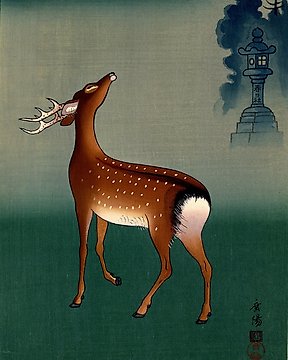
Eredeti fametszet, Kiadó: Kyōto hanga'in 京都版画院 - Papír - Ōmura Kōyō 大村廣陽 (1891-1983) - 'Kasuga-taisha no shika' 春日大社の鹿 (Sacred deer of Kasuga Shrine) (tentative title) - Japán - kb 1950
Nr. 83698337

Nr. 83698337

Original woodblock print, Published by watanabe – Yamamura Toyonari (1885-1942) – “Hatsu yo nakamura ganjirō no akane hanshichi” 初世中村鴈治郎の茜半七(The Actor Nakamura Ganjiro I as Akane Hanshichi : Stars of the Theatrical World of Kabuki) –Heisei period (1989-2019)
Actors
初世中村鴈治郎の茜半七 The Actor Nakamura Ganjiro I as Akane Hanshichi : Stars of the Theatrical World of Kabuki.
This is singed “Toyonarie” (豊成画).
First edition 1925(Taisho 15 period). This is a later edition
See Harvard Art Museums: https://harvardartmuseums.org/art/208688
A disciple of Kubota Beisen and Kubota Kinen.
His real name is Yoshinosuke. He used sername shunsen(春僊), Harukawa(春川), Mayuko-dong(黛子洞), Kajitsutei(梶蔦亭), and Seishitei(青紫亭)an art name.
Born in Akiho-mura, Nakakoma-gun, Yamanashi Prefecture (currently Ogasawara, Minami-Alps) as the fifth son of Shiro Natori and Michi. My father, Ichitaro, is a cotton wholesaler called Ryogokuya, which also sells miscellaneous goods, started a financial business in the Gosai region, Juensha, and contributed funds with Ippei Wakao when the 10th National Bank was established, the first in Yamanashi Prefecture. He was also one of the members of the prefectural assembly. However, due to the failure of his father’s business, he moved to Tokyo at the age of one.
In 1892 (Meiji 25), he entered Tokyo Municipal Joto Hirotsugu High School. He was recognized for his artistic talent along with his alumni Kawabata Ryuko, Ippei Okamoto, and Katsunosuke Nakata. At the age of 11, he learned the basics and coloring of Japanese painting from Ayaoka (Ikeda) Yuma. In 1900 (Meiji 33),
He became a disciple of Beisen(Beisen) at the age of 14, and learned from Kinsen(金遷) after his blindness. In 1904 (Meiji 37), he entered the Japanese painting department of the Tokyo Fine Arts School, and in 1905 (Meiji 38) he also studied Western painting at Fukuietei and became a private scholar of Hirafuku Hyakusui. In the same year he dropped out of Tokyo Fine Arts School.
In 1915 (Taisho 4), he published a yakusyu-e(役者絵) in the small magazine “New Caricature(新似顔)”.
The following year, 1916 (Taisho 5), the hand-drawn painting “Ganjirō no wankyū'(鴈治郎の椀久)” exhibited at the 2nd “Drama Exhibition(劇画展覧会)” held at the Kyobashi Painting Expo caught the eye of Shozaburo Watanabe, and Watanabe Print Shop. The actor’s picture “Jibei Kamiya of the first Nakamura Ganjiro(初代中村鴈治郎の紙屋治兵衛)” was printed, and this was Shunsen’s first shinhanga(新版画) work.
This work became his masterpiece. After that, in 1917 (Taisho 6), “Umeyuki no Tomi(梅幸のお富)” was published. Shunsen’s works were later compiled into “Creative Prints Shunsen Caricature Collection(創作版画 春仙似顔絵集)” and published from 1925 (Taisho 14) to 1929 (Showa 4). German ambassadors Wilhelm Solf, Yorisada Tokugawa, and Renkichi Takami, who saw this portrait collection, asked Shunsen for portraits in woodblock prints and produced them. Shunsen created more than 100 kinds of prints, and was a representative of the actor Okubi-e in the new prints with Koka Yamamura. He also works on handwriting.
In 1930 (Showa 5), the American magazine “American Magagen of Art” introduced the achievements of Shunsen’s prints with Shinsui Ito and Hasui Kawase.
Hogyan vásárolhatok a Catawiki-n?
1. Fedezzen fel valami különlegeset
2. Tegye meg a legmagasabb licitet
3. Fizessen a biztonságos és védett rendszert használva